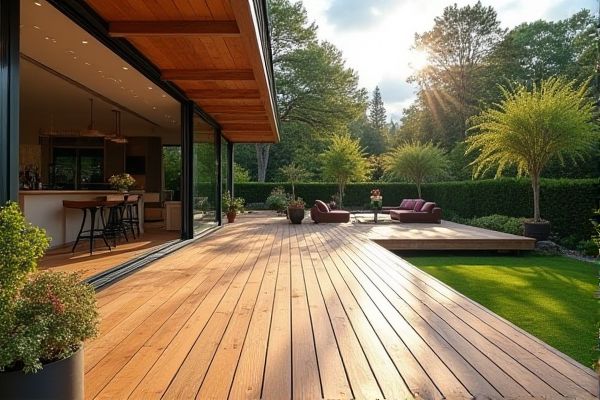
Wooden decking offers natural beauty and a classic feel but requires regular maintenance to prevent rot, warping, and insect damage, while composite decking provides durability, low upkeep, and resistance to weathering with a modern aesthetic. Discover which option best suits Your outdoor space and lifestyle by exploring the detailed comparisons ahead.
Table of Comparison
| Feature | Wooden Decking | Composite Decking |
|---|---|---|
| Material | Natural wood (cedar, redwood, pine) | Wood-plastic composite (wood fibers + recycled plastic) |
| Durability | Moderate; prone to rot, splitting, insect damage | High; resistant to rot, insects, and splintering |
| Maintenance | Requires regular staining, sealing, and cleaning | Low maintenance; occasional cleaning recommended |
| Lifespan | 10-15 years (with maintenance) | 25-30 years |
| Cost | Lower upfront cost | Higher upfront cost |
| Appearance | Natural wood grain and texture | Varies; mimics wood but less authentic |
| Environmental Impact | Renewable resource but requires chemicals for treatment | Recycled materials; reduces wood use but plastic-based |
| Installation | Requires skilled labor; may warp over time | Easy installation; stable and uniform |
| Resale Value | Moderate impact on home value | Higher impact due to durability and low maintenance |
Introduction to Wooden and Composite Decking
Wooden decking offers natural beauty and warmth, crafted from durable hardwoods like cedar, redwood, or pressure-treated pine, providing a traditional outdoor aesthetic. Composite decking combines wood fibers with recycled plastic to deliver enhanced durability, low maintenance, and resistance to rot, insects, and fading. Choosing between wooden and composite decking depends on factors such as budget, maintenance preferences, environmental impact, and desired lifespan.
Material Composition: Wood vs Composite
Wooden decking is crafted from natural timber, typically cedar, redwood, or pressure-treated pine, offering authentic grain patterns and a warm, organic feel. Composite decking combines wood fibers with recycled plastic, creating a durable and low-maintenance material resistant to rot, insects, and fading. The choice between wood and composite decking affects factors like longevity, maintenance requirements, and environmental impact, with composite often favored for sustainability and durability.
Aesthetic Appeal and Design Options
Wooden decking offers a classic, natural aesthetic with unique grain patterns and the ability to age gracefully, providing a timeless appeal unmatched by synthetic materials. Composite decking boasts a wide range of colors, textures, and finishes that mimic wood while offering consistent appearance and resistance to fading, warping, and staining. Both options allow for versatile design choices, but composite decks enable more uniformity and low-maintenance beauty in complex or high-traffic outdoor living spaces.
Durability and Longevity Comparison
Wooden decking offers natural aesthetics but is prone to rot, warping, and insect damage, requiring regular maintenance to maintain durability. Composite decking, made from a blend of wood fibers and plastic, provides superior resistance to moisture, fading, and pests, significantly extending its lifespan. Your investment in composite decking ensures long-term durability with minimal upkeep, making it a cost-effective choice for lasting outdoor spaces.
Maintenance Requirements: Wooden vs Composite
Wooden decking requires regular maintenance such as sealing, staining, and sanding to prevent rot, splintering, and weather damage, making it labor-intensive over time. Composite decking offers a low-maintenance alternative, needing only occasional cleaning with soap and water due to its resistance to fading, mold, and insects. Choosing composite decking can save Your time and effort by minimizing upkeep while still providing a durable and attractive outdoor surface.
Environmental Impact and Sustainability
Wooden decking is sourced from natural timber, which can be sustainable if harvested from responsibly managed forests certified by organizations like FSC, but it requires regular maintenance and treatments that may involve harmful chemicals. Composite decking is made from recycled wood fibers and plastic, reducing landfill waste and demand for virgin timber, and it typically requires less maintenance with no need for toxic sealants, contributing to lower environmental impact over its lifespan. Choosing the right decking for your project affects sustainability, with composite decking often preferred for eco-friendly durability, while wood offers a biodegradable option if sourced responsibly.
Cost Analysis and Budget Considerations
Wooden decking typically has a lower initial cost but requires more maintenance over time, increasing long-term expenses. Composite decking demands a higher upfront investment but offers durability and minimal upkeep, often resulting in better cost efficiency. Your budget should factor in both immediate costs and future maintenance to determine the best decking option.
Installation Process and Complexity
Wooden decking installation requires precise measurement, cutting, and nailing, with careful attention to moisture content to prevent warping and splitting; it often demands more time and skill due to its natural variability. Composite decking features a more straightforward installation process with uniform materials and pre-designed fastening systems that reduce the need for complex cutting and fastening, leading to faster assembly and fewer mistakes. While wooden decks may require additional treatment and sealing during installation, composite decks come ready to install with minimal maintenance requirements, appealing to both beginners and professionals.
Comfort and Safety Underfoot
Wooden decking offers a natural warmth and slight texture that can feel comfortable underfoot, but it may become slippery when wet and requires regular maintenance to avoid splinters or cracks. Composite decking provides a more consistent surface with slip-resistant properties and heat resistance, enhancing safety and reducing discomfort on hot summer days. Your choice impacts comfort and safety, with composite decking often preferred for even surfaces and long-term durability.
Pros and Cons: Wooden Decking vs Composite Decking
Wooden decking offers natural beauty and a warm, authentic feel but requires regular maintenance such as sanding, staining, and sealing to prevent rot and splintering. Composite decking provides durability and low maintenance with resistance to insects, mold, and fading, though it can be more expensive upfront and may lack the same natural appearance as wood. Your choice depends on whether you prioritize traditional aesthetics with upkeep or long-term ease with synthetic materials.
 homyna.com
homyna.com